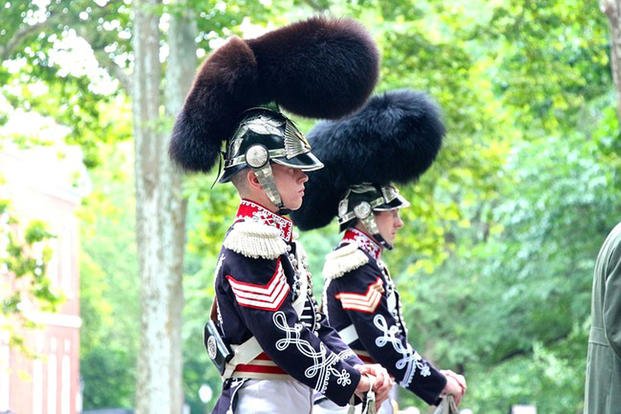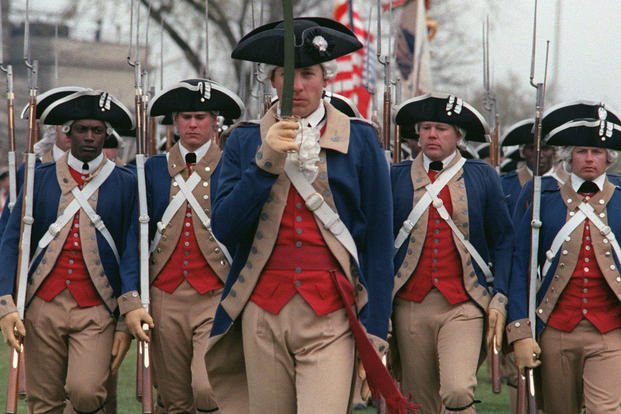Soon the U.S. Army will have a new retro look as it transitions to its new "Army Greens" throwback uniforms, based on the "Pinks and Greens" of World War II. The blue Army Service Uniform will become more and more rare as it phases out.
A lot of rarely worn uniform items stay in circulation a long time, either because of the saltier troops who hang onto them or because they're just worth keeping around.
Here are few of those rare items. Some are still in use (though you may have to go looking for them), while others are recently deceased.
7. The Marine Corps' Evening Dress Boat Cloak
Virtually extinct in the wild but still authorized for wear is the boat cloak for male officers and senior noncommissioned officers. It is intended for evening dress but can also be worn with blue dress A/B uniforms for official social functions -- unless the blue dress uniform is the uniform of the day.

There is anecdotal evidence of the existence of the boat cloak, but its rarity can probably be best explained by the fact that it's made-to-order at the MCX and can cost more than $1,000.
6. Army Dress Whites
Dress whites weren't just for the Navy for much of U.S. military history. Both the Air Force and the Army sported nifty dress whites, as did the Marine Corps. The uniforms weren't just for formal ceremonies, either. They were worn as an everyday uniform for troops in tropical climates, such as the former Panama Canal Zone.

Air Force Chief of Staff Merrill McPeak did away with the Air Force whites in the early 1990s, and the Marine Corps whites were phased out by 2000. The Army held on a little bit longer, doing away with the uniform in 2007.
5. Coast Guard Tropical Blue Shorts
These days, when new Coasties are told to wear their Trops as the uniform of the day, some of the saltier Guardsmen might accidentally refer to them as Tropical Blue Long, instead of the new term, Tropical Blues. The reason is that there used to be a Tropical Blue Short version.
Laid-back Coast Guard crews might even wear a uniform polot with their Trops. The Shorts version is now long gone.
4. Navy Aviation Greens
If the Army can wear white, why can't the Navy wear green? In the earliest days of Naval Aviation, aviators wore green uniforms, distinct from other officers' uniforms. Flying was a dirty job, and the grease, fuel and oil stained wreaked havoc on the uniforms of the day. The Navy's aviation greens became an aviator's working uniform.

Aviation greens underwent minor changes throughout the years, but one thing remained the same: the color green. It wasn't until the Navy introduced its Type I digital "blueberries" uniform in 2010 that the aviation greens finally went by the board.
3. U.S. Army's 1st Cavalry Horse Detachment
When you think of calling in the cavalry, these are the guys you think about. Not only is the 1st Cavalry the only cavalry unit to still ride horses, they're also the only Army unit to sport full throwback uniforms hailing the glory days of American horse cavalry.

These throwbacks come complete with Springfield model 1873 carbine rifles, a model 1860 cavalry saber, and a Colt single-action Army "Peacemaker" revolver.
2. First Troop Philadelphia City Cavalry

The Pennsylvania Army National Guard's First Troop Philadelphia City Cavalry is a military unit older than the U.S. Army itself. As such, it has a couple of special provisions that exempt it from some of the Militia Acts of the late 1790s that organized and standardized the Army, so its traditions have never gone away -- including its distinctive ceremonial uniforms.
1. The Commander-In-Chief's Guard
Officially, Company A, 4th Battalion, 3rd U.S. Infantry Regiment can be called out to help control civil unrest in the Washington, DC area. But as a Special Ceremonial Unit, the "Commander In Chief's Guard," as Company A has been called since America's bicentennial, performs ceremonial duties.

At official state functions, like a Presidential Inauguration or a state visit from a foreign leader, this special unit dons the blue greatcoats, powdered wigs, and tricorn hat of the Continental Army era, complete with a Brown Bess-type musket that was the premier infantry weapon of the time.
-- Blake Stilwell can be reached at blake.stilwell@military.com.
Want to Learn More About Military Life?
Whether you're thinking of joining the military, looking for post-military careers or keeping up with military life and benefits, Military.com has you covered. Subscribe to Military.com to have military news, updates and resources delivered directly to your inbox.















